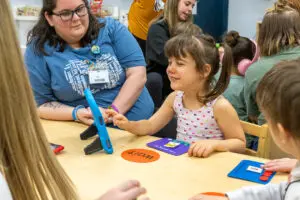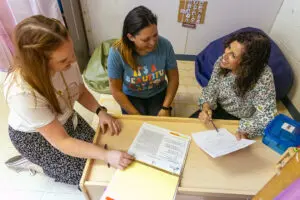Pyramid USA Consultants, Jill M. Waegenaere, M.A., CCC-SLP, and Molly Lingo, M.Ed., BCBA, discuss collaboration between SLPs and BCBAs.
 In a recent PECS Overview training we presented together, we had a specific question on how BCBAs and SLPs could best collaborate. After hearing each other’s responses to this question, we thought this topic was worthy of a blog post! Criticisms regarding the science of behaviour analysis have dominated various social media platforms lately. In addition, some trends in the field of speech pathology are being questioned by behaviour analysts. Many SLPs and BCBAs have publicly shared challenges with collaboration between the two fields. Through understanding the differences and similarities in approaches between speech pathologists and behaviour analysts, we feel that we can engage in harmonious collaboration. The goal of collaboration in our eyes is not to give something up or feel pressure to simply compromise, but to create more for the learner by gaining the knowledge required to provide our learners with the best possible educational experiences. Okay, so how do we play nice in the sandbox….?
In a recent PECS Overview training we presented together, we had a specific question on how BCBAs and SLPs could best collaborate. After hearing each other’s responses to this question, we thought this topic was worthy of a blog post! Criticisms regarding the science of behaviour analysis have dominated various social media platforms lately. In addition, some trends in the field of speech pathology are being questioned by behaviour analysts. Many SLPs and BCBAs have publicly shared challenges with collaboration between the two fields. Through understanding the differences and similarities in approaches between speech pathologists and behaviour analysts, we feel that we can engage in harmonious collaboration. The goal of collaboration in our eyes is not to give something up or feel pressure to simply compromise, but to create more for the learner by gaining the knowledge required to provide our learners with the best possible educational experiences. Okay, so how do we play nice in the sandbox….?
Molly was hired in August and by chance Jill was lucky enough to be her mentor. After her initial training period, our discussions transitioned to more clinical topics, and we quickly realized that we needed to understand each other’s backgrounds to meet the needs of the learners and teams we were consulting to. We both have training on different theories and philosophies. When thinking about language development, Molly has extensive training in Skinner’s analysis of Verbal Behavior, whereas Jill has extensive training in developmental models such as Brown’s Stages of Syntactic and Morphological Development. Due to these varied backgrounds, we often find eliminating jargon to be helpful. Rather than using the term “intraverbal” we may change it to “when asking WH questions.” This simple action lends respect to the fact that not everyone has the same training or will use the same lingo. It can also avoid confusion and reduce the apprehension some colleagues may feel about asking for clarification.
 Just knowing how to teach something isn’t always enough. Utilizing knowledge from other fields and collaborating with other disciplines leads to a better outcome for our learners. BAs are always analyzing communication under different conditions, whereas the SLP is more focused on form (did they say it?, was it articulate?). During a Pyramid Certified Classroom (PCC) consultation visit, we reviewed several Behaviour Intervention Plans (BIPs) together. We utilized Molly’s BCBA background to review data and determine the function of the behaviour and Jill’s SLP training to teach the functionally equivalent alternative behaviours (FEAB). Many of the alternative behaviours were communication skills. For example, one learner was dropping to the floor and crying when waiting a turn for a preferred toy several times per school day. Through our collaborative discussion, we determined the data showed the function of the behaviour was to gain access to preferred items and a FEAB for this learner would be to teach how to wait using a visual. We discussed with the team how to teach the skill, starting with small increments of wait time slowly shaping the amount of wait time to the target goal of 2 minutes. After a couple of weeks, the learner was successfully waiting without dropping to the floor or crying for preferred toys, and snacks. The team was proud of what they had accomplished with this learner, and this experience further reinforced the need for ongoing collaboration between our fields.
Just knowing how to teach something isn’t always enough. Utilizing knowledge from other fields and collaborating with other disciplines leads to a better outcome for our learners. BAs are always analyzing communication under different conditions, whereas the SLP is more focused on form (did they say it?, was it articulate?). During a Pyramid Certified Classroom (PCC) consultation visit, we reviewed several Behaviour Intervention Plans (BIPs) together. We utilized Molly’s BCBA background to review data and determine the function of the behaviour and Jill’s SLP training to teach the functionally equivalent alternative behaviours (FEAB). Many of the alternative behaviours were communication skills. For example, one learner was dropping to the floor and crying when waiting a turn for a preferred toy several times per school day. Through our collaborative discussion, we determined the data showed the function of the behaviour was to gain access to preferred items and a FEAB for this learner would be to teach how to wait using a visual. We discussed with the team how to teach the skill, starting with small increments of wait time slowly shaping the amount of wait time to the target goal of 2 minutes. After a couple of weeks, the learner was successfully waiting without dropping to the floor or crying for preferred toys, and snacks. The team was proud of what they had accomplished with this learner, and this experience further reinforced the need for ongoing collaboration between our fields.

BELOW ARE SOME QUICK TIPS WE OFTEN USE AS CONSULTANTS OURSELVES AND RECOMMEND TO TEAMS:
- Avoid jargon
For example, use the word “request” rather than “mand” - Share philosophies and approaches
We all learn from each other - Remain goal oriented
Remember, it’s not about us, it’s about the learner - Make time to talk to colleagues
Not just at work but also outside of a stressful work environment - Try approaches before you knock ‘em
Rely on the training and perspectives of others, not just your own
Assess don’t guess, turn to the data for decisions - Attend training or conventions together
When all team members are hearing the same information, it’s not just hearsay
When we have multiple backgrounds working together, our learners get the most benefit. The Pyramid Approach to Education (PAE) emphasizes a team-based approach to creating an effective educational environment. When implemented, the Pyramid Approach puts all team members on a level playing field where we communicate, learn from each other, and focus on the learner.
LEARN MORE:
- Learn more about the Pyramid Approach to Education
- Teaching Critical Communication Skills On-Demand Workshop
- Register for ABA for SLP’s online training
- Check out our free materials and resources
Written by Jill M. Waegenaere, M.A., CCC-SLP, and Molly Lingo, M.Ed., BCBA
© Pyramid Educational Consultants, LLC. 2024
